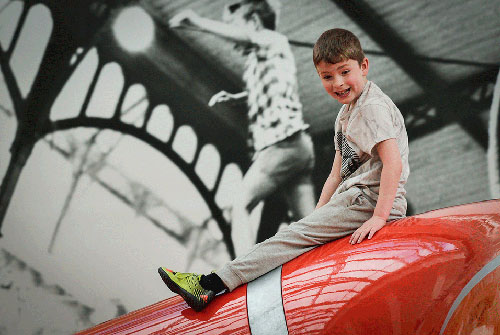정준모
BALTIC Centre for Contemporary Art opens 'The Playground Project'

The Playground Project installation view, BALTIC Centre for Contemporary Art, Gateshead.
Photo: Mark Pinder/Meta-4.
GATESHEAD.- BALTIC Centre for Contemporary Art, Gateshead is presenting the exhibition The Playground Project.
Until the 1980s – and in rare cases today – playgrounds were places for social experiments, risky projects, and spectacular sculptures. Architects, urban planners, artists, parents, and children were invited to leave their comfort zone and to venture into something new.
The Playground Project brings many of these exemplary, but nowadays forgotten, initiatives, pioneering acts and adventures back with a playground in which children (and inner children) can run, hide and climb. All visitors are encouraged to play.
The playground is a by-product of the industrialised city of the twentieth-century. Even now, it continues to be both an ugly duckling and a coveted space. A focal point for ideas about education and childhood, about urban planning and public space, about architecture and art, about creativity and control, the playground has repeatedly resisted institutional and ideological appropriation and grown in its own sometimes quite anarchic ways. The coexistence of contradictory expectations, moments of temporary progress, and radical developments makes playgrounds all the more exciting.
Still, as hardly anyone sees playgrounds as part of their cultural heritage, much of their history has been forgotten or can barely be understood anymore—despite most of us having precise personal memories of this place where we met our friends, took pride in new things we dared to do, braved danger without thinking about it, and learned to confront and resolve conflict.
There have been four paradigm shifts in the development of the playground in the course of the last 150 years. First, at the beginning of the twentieth-century, social reformers took children off the street and onto the playground. Then, at the beginning of the 1930s, the idea arose that children should play with natural materials rather than playground equipment. In the 1960s, the decade of autonomy and do-it-yourself, parents, children, and neighbourhood groups began to take charge of playgrounds themselves. Finally, in the 1980s, with the end of social and political utopias, a crisis in playground design began. Today, a pioneering new spirit is being generated by young architects and artists, collectives and activists. These designers, who often share their experiences on the internet, are creating new play spaces with efficient means.
Including work by Marjory Allen (Lady Allen of Hurtwood), Joseph Brown, Riccardo Dalisi, Richard Dattner, Aldo van Eyck, M. Paul Friedberg, Michael Grossert, Cornelia Hahn Oberlander, Alfred Ledermann, Yvan Pestalozzi, Group Ludic, Egon Møller-Nielsen, Palle Nielsen, Isamu Noguchi, Sreejata Roy, Niki de Saint Phalle, Josef Schagerl, Mitsuru (Man) Senda, Carl Theodor Sørensen, Alfred Trachsel and more.
The exhibition is accompanied by a comprehensive catalogue The Playground Project, edited by Gabriela Burkhalter, with contributions by Daniel Baumann, Gabriela Burkhalter, Vincent Romagny, Sreejata Roy, and Xavier de la Salle, German/English, Kunsthalle Zürich / JRP|Ringier 2016, CHF 48.
FAMILY SITE
copyright © 2012 KIM DALJIN ART RESEARCH AND CONSULTING. All Rights reserved
이 페이지는 서울아트가이드에서 제공됩니다. This page provided by Seoul Art Guide.
다음 브라우져 에서 최적화 되어있습니다. This page optimized for these browsers. over IE 8, Chrome, FireFox, Safari